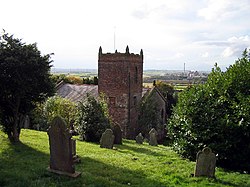South Ferriby
| South Ferriby | |
| Lincolnshire | |
|---|---|
 St Nicholas' Church, South Ferriby | |
| Location | |
| Grid reference: | SE987210 |
| Location: | 53°40’38"N, -0°30’24"W |
| Data | |
| Population: | 651 (2011) |
| Post town: | Barton-Upon-Humber |
| Postcode: | DN18 |
| Dialling code: | 01652 |
| Local Government | |
| Council: | North Lincolnshire |
| Parliamentary constituency: |
Brigg and Goole |
South Ferriby is a village in Lincolnshire, at the very northern edge of the county, on the south bank of the Humber Estuary, three miles west of the Humber Bridge. Directly across the Humber in Yorkshire stands North Ferriby.
The village population was recorded as 651 in 2011.
History
In Roman there was a major settlement nearby, known locally as one of the 'Low Villages' at the bottom of a chalk escarpment, where the chalk meets the clay: before piped water the location provided a plentiful water supply.[1][citation needed] The village also marks the point where the Lincolnshire Wolds meet the Humber Estuary and was, as the name suggests,[2] the southern end of an ancient ferry over the Humber to North Ferriby.
The entry in the Domesday Book of 1086 records a church, a mill and two ferries.
South Ferriby was once two villages, Ferriby Sluice with its strong connection to brick manufacture and other activities on the River Ancholme and South Ferriby with two farms (that are still operational). The village has a general store with post office, garage, primary school and two public houses: the Nelthorpe Arms, which has recently been brought back to life in a £370,000 refit in 2018, named after the family who at the beginning of the 19th century owned over half the village (and still have major holdings today), and, down by the Sluice, the Hope and Anchor which looks out over the Humber with Read's Island and its wildlife.
The village was badly flooded in the storm surge of December 2013.[3]
Parish church
The paprish church, St Nicholas, dates to the 13th century;[4] it is a structure consisting of nave, south transept, north porch and an embattled tower with pinnacles at the south-east corner containing 3 bells. Over the porch is tympanum, on which is a sculptured figure of St Nicholas, vested in alb and mitre and holding a pastoral staff in his left hand and on either side are symbolical figures of the Sun and Moon.
The unusual north–south alignment of the current church is a legacy of a Victorian enlargements of the church. The Creed and Commandment boards survived in the vestry in the 1990s, and the present pulpit is a surviving element of the 18th century two- or three-decker pulpit dismantled during the 1870s reordering of the church. This was the chancel prior to the 1870s, the nave of the church having been rebuilt almost square following a landslip caused by water springs in the late 16th century.[5]
The church is a Grade II* listed building.[4]
About the village
Ferriby Hall is now a private residence once again, having formerly been used as nursing home. Originally a private house until at least the 1960s. In 1953 some contents of the house were lent to Hull Museum on permanent loan. The house was owned in the 1960s by the Booty Family but had to be sold after Leonard Booty, grandson of Frederick Booty absconded with the family inheritance.[6]
South Ferriby is on the route of the Viking Way, a 147-mile long-distance footpath from the Humber Bridge to Oakham in Rutland, and is on the side of an escarpment overlooking the Ancholme valley. The A1077 climbs the steep escarpment at this point, and meets the B1204 from the south, which follows the escarpment to Elsham Hall Country Park. The A1077 is sometimes closed to let boats through the sluice.
Economy
The only industry is the cement works. The plant, owned by Cemex (formerly Rugby Cement, and before that Eastwood's Humber Cement), is a prominent landmark in the village, and obtains its raw material from the Middlegate Lane quarry on the hill above.[7] There is an overhead conveyor belt that passes to the south of the village from the Middlegate Lane quarry to the cement processing works to the south-west over the River Ancholme.
In May 2020, Cemex announced its intention to mothball the plant in the autumn of 2020.
Outside links
| ("Wikimedia Commons" has material about South Ferriby) |
References
- ↑ "An introduction to the council and information about the village of South Ferriby" (in en-GB). https://www.southferribyparishcouncil.gov.uk/.
- ↑ Ekwall, Eilert, The Concise Oxford Dictionary of English Place-Names. Oxford, Oxford University Press, 4th edition, 1960. p. 178 ISBN 0198691033
- ↑ Cole, Nick (6 December 2013). "Village Devastated". Scunthorpe Telegraph. http://www.scunthorpetelegraph.co.uk/VILLAGE-DEVASTATED-8216-Worst-day-history-South/story-20271356-detail/story.html. "Roy Holloway, the chairman of the parish council said: "This is the worst day in the history of the village""
- ↑ 4.0 4.1 National Heritage List 1288277: Church Of Saint Nicholas (Grade II* listing)
- ↑ J. Collingwood & J. Trier, Calendar of Patent Rolls, 1575-1578 (London: HMSO, 1982), p. 582 no. 3666.
- ↑ Ellwood, Stephen (18 February 2016) - Grandson of Leonard Booty
- ↑ "Cement Kilns: South Ferriby". http://www.cementkilns.co.uk/cement_kiln_ferriby.html.
